Journal, Ledger and Trial Balance - Accountancy and Financial Management | Accountancy and Financial Management - B Com PDF Download
| Table of contents |

|
| Journal |

|
| Rules of Debit and Credit |

|
| Ledger |

|
| Ledger Accounts |

|
| Difference between Journal and Ledger |

|
| Trial Balance |

|
The main goal of financial accounting is to keep track of financial transactions and figure out how the business is doing over a year. This involves making financial statements like the Profit and Loss Account and Balance Sheet at the end of the year. When a transaction happens, the process of recording it in the account books begins.
This process of accounting involves a series of steps, starting from when a transaction occurs and ending with closing the account books at the end of the year. Since this sequence of steps is repeated in the same order every year, it's also called the accounting cycle.

Journal
- A journal is a book of first entry. It is a preliminary book to provide a chronological record of transactions in which each transaction is recorded with relevant supplementary information.
- Journal is known as a book of original entries because the transactions are first recorded in the journal and it is from this record that various accounts are posted in the ledger.
- A journal is also known as a subsidiary book or day book. The process of recording transactions in the journal is known as journalising.
- A journal is a record of financial transactions that are sorted by date.
 Journal Format
Journal Format
- With today's computerized bookkeeping and accounting, it is likely to find only a general journal in which adjusting entries and unique financial transactions are entered. The recording and posting of most transactions will occur automatically when sales and vendor invoice information is entered, checks are written, etc. In other words, accounting software has eliminated the need to record routine transactions in a journal.
- The journal has the following five columns:
1. Date: This column records the date when transaction is entered in journal.
2. Particulars: In this column the accounts to be debited and credited are entered. The name of the account to be debited is written first and in the next line, the account to be credited is written preceded by the word ‘To’. A brief explanation of the transaction known as ‘Narration’ is also given below the account to be credited.
3. L.F. i.e. Ledger Folio: It means the page numbers of the ledger in which these accounts appear in the ledger.
4. Debit (Dr): Amount In this column, the amount to be debited is entered.
5. Credit (Cr): Amount In this column, the amount to be credited is entered.

- A single-entry journal has one debit and one credit.
- A compound entry journal has one debit and more than one credit, or more than one debit and one credit.
- In a compound entry journal, the total of the debit and credit entries must match.
Advantages of the journal:
(a) Helps reduce errors by comparing debits and credits.
(b) Allows for detailed explanations alongside entries.
(c) Entries are made in chronological order.
Limitations of the journal:
(a) Recording every transaction in one journal can make it too lengthy.
(b) Many firms prefer to record cash transactions directly in a separate book for daily cash balance tracking.
(c) Keeping separate journals for different types of transactions makes bookkeeping and accounting simpler, as entries can often be made in totals.
Recording in Journal
Transactions in the journal are recorded based on the rules of debit and credit of the double-entry system. They are classified into three categories: transactions involving individuals, transactions involving business assets and properties, and transactions involving business expenses and incomes.
Types of Accounts
There are three types of accounts, i.e., personal, real and nominal.

(a) Personal Accounts: This includes:
(i) Accounts of natural persons, e.g., debtor’s a/c, creditor’s a/c, Ram’s a/c, etc.
(ii) Accounts of artificial persons and body of persons e.g., partnership firm’s a/c, company’s a/c, bank a/c, club’s a/c, insurance company’s, etc.
(iii) Representative personal accounts When an account represent a certain person, it is called representative personal account. For example, if salary of 10 employees has not been paid, the total amount due to these employees will be added and shown under one common account called ‘salaries outstanding a/c’, but in the books the names of employees will appear. Therefore, salaries outstanding a/c is a personal account because it represents certain persons. Similarly, insurance prepaid a/c, rent outstanding a/c, interest accrued a/c, etc. are personal accounts.
(b) Real Accounts: These are accounts of things tangible or intangible, e.g., furniture a/c, cash a/c, goodwill a/c, patent rights a/c, machinery a/c, land and building a/c, etc.
(c) Nominal Account: These are accounts of expenses (and losses) and incomes (and gains), e.g., interest paid a/c, wages a/c, interest earned a/c, commission a/c, rent a/c, discount a/c, profit on sale of old machine a/c, etc.
Rules of Debit and Credit
A. Traditional Approach
Under this approach, Accounts are classified in to three namely real accounts, personal accounts and nominal accounts. There are separate rules for each type of accounts they are as follows1. Real accounts: An account relating to an asset or property is called real account. Cash, furniture, plant and machinery etc are examples of real accounts the debit, credit rule applicable to real account is:
Debit what comes in
Credit what goes out
2. Personal accounts: It includes the account of person with whom the business deals. These accounts are classified in to three categories
a) Natural personal accounts: The term natural persons mean persons who are creation of god. For e.g.;-Raja’s accounts, Gupta’s accounts etc.
b) Artificial personal accounts: These accounts includes accounts of corporate bodies or institutions
c) Representative personal account-these are accounts which represents certain person or group of persons. For example salary due, rent outstanding etc. The rule of personal account is
Debit the receiver
Credit the giver
3) Nominal accounts: Accounts relating to expenses and losses and incomes and gains are called nominal accounts. Salary accounts, commission account etc are examples. The rule of nominal account is
Debit all expenses and losses
Credit all incomes and gains

B. Modern Approach
Under this approach, accounts are classified into five categories namely Assets, Liabilities, Capital, Incomes & Gains and Expenses & Losses. There are separate rules for each particular which are as follows:

Ledger
- A ledger account is a summary of all transactions related to a person, asset, expense, or income for a specific period. It shows the overall effect of these transactions.
- Every entry from the journal must be transferred to the ledger.
- The ledger is like a 'T' shape and serves as the main book of accounts.
 Ledger Format
Ledger Format
- In the ledger, each account should have its own account. The format of a ledger account is like a 'T', with two sides, debit, and credit.
- If a transaction is recorded on the debit side, then the word 'To' is added. However, if the transaction is being recorded on the credit side, the word 'By' is used, along with the account name.
- At the end of the financial year, the ledger account is balanced by totalling the two sides and calculating the difference. If the debit side is higher, then there is a debit balance. If the credit side is higher, then there is a credit balance.
- If an account has a debit balance, then on the credit side, it is noted as "By Balance c/d" with the difference amount. This way, both sides will match.
- At the beginning of the new period, the opening balance is transferred to the opposite side with "To Balance b/d". 'c/d' refers to carried down and 'b/d' means brought down.
Ledger Accounts
Accounting Entries are recorded in ledger accounts. Debit entries are made on the left side of the ledger account, whereas Credit entries are made on the right side. Ledger accounts are maintained in respect of every component of the financial statements.
Ledger accounts may be divided into two main types:
1. Balance Sheet Ledger Accounts
Balance Sheet ledger accounts are maintained in respect of each asset, liability, and equity component of the statement of financial position.
Following is an example of a receivable ledger account:

- Balance brought down is the opening balance in respect of the receivable at the start of the accounting period.
- These are credit sales made during the period. The receivables account is debited because it has the effect of increasing the receivable asset. The corresponding credit entry is made to the Sales ledger account. The account in which the corresponding entry is made is always shown next to the amount, which is the Sales ledger.
- This is the amount of cash received from the debtor. Receiving cash has the effect of reducing the receivable asset and is therefore shown on the credit side. As it can be seen, the corresponding debit entry is made in the cash ledger.
- This represents the balance due from the debtor at the end of the accounting period. The figure arrived by subtracting the amount shown on the credit side from the sum of the amounts shown on the debit side. This accounting period's closing balance is being carried forward as the opening balance of the next period.
- Similar ledger accounts can be made for other balance sheet components such as payables, inventory, equity capital, noncurrent assets, etc.
2. Income Statement Ledger Accounts
Income statement ledger accounts are maintained in respect of incomes and expenditures.
Example of electricity expense ledger:

- This is the amount of cash paid against the electricity bill. The expense ledger is being debited to account for the increase in expenses. The corresponding credit entry has been made in the cash ledger.
- This represents the amount of expense charged to the income statement. The balance in the ledger has been recycled to the income statement, which is debited by the same amount. Unlike balance sheet ledger accounts, no balance is brought down or carried forward. Instead, the income statement ledger is closed each accounting period ends with the balancing figure representing the charge to the income statement.
- Similar ledger accounts can be made for other income statement components.
Ledger Posting
Ledger posting is the process of transferring debits and credits from the journal to the ledger accounts. Each debit listed in the journal's debit column is entered on the debit side of the ledger account, while each credit listed in the journal's credit column is entered on the credit side of the ledger account. Here's how posting to the ledger is done:
- Find the first account named in the journal entry in the ledger.
- Write the debit amount in the debit column of the ledger account, with 'To' and the account name.
- Record the transaction date in the date column of the ledger account.
- Write the journal page number in the journal folio column of the ledger account.
- Once the debit entry is done, note down the ledger page number in the journal's ledger folio column.
- Repeat the above steps for the credit side of the journal entry.
Balancing of Ledger Accounts
- Balancing a ledger account means making sure the total on the debit side equals the total on the credit side. After posting all transactions, you find the difference between the two sides.
- If the debit side total is higher, it has a debit balance; if the credit side total is higher, it has a credit balance.
- To balance the account, you write "To or By Balance c/d" on the shorter side, so both sides are equal.
- In the next period, the account starts with "To or By Balance brought down" on the side with the higher total. If both sides are equal, the account is balanced.
Difference between Journal and Ledger
- The Journal and Ledger are the two pillars that create the base for preparing final accounts.
- The Journal is a book where all the transactions are recorded immediately when they occur, which is then classified and transferred into the concerned account known as Ledger.
- The journal is also known as the book of primary entries, which records transactions chronologically.
- On the other hand, Ledger, or the principal book, implies a set of accounts in which similar transactions relating to a person, asset, revenue, liability, or expense are tracked.

Trial Balance
- A Trial Balance is a statement that shows the debit balances and credit balances separately for each account. It's made after posting all ledger accounts and finding their balances.
- Every account and its balance are listed, with debits in one column and credits in another. The totals of the debit and credit columns must be the same.
- If they are equal, it suggests there are no arithmetic errors. This is because in the Double Entry System, the total debits always equal the total credits. However, finding this equality doesn't guarantee complete accuracy, as other types of errors could still exist.

Purpose of a Trial Balance
- Trial Balance acts as the first step in the preparation of financial statements. It is a working paper that accountants use as a basis while preparing financial statements.
- Trial balance ensures that for every debit entry recorded, a corresponding credit entry has been recorded in the books by the double entry concept of accounting. If the totals of the trial balance do not agree, the differences may be investigated and resolved before financial statements are prepared. Rectifying basic accounting errors can be a much longer task after the financial statements have been prepared because of the changes that would be required to correct the financial statements.
- Trial balance ensures that the account balances are accurately extracted from accounting ledgers.
- Trail balance assists in the identification and rectification of errors

Limitations of a trial balance
- Trial Balance only confirms that the total of all debit balances matches the total of all credit balances.
- Trial balance totals may agree despite errors. An example would be an incorrect debit entry offset by an equal credit entry.
- Likewise, a trial balance gives no proof that certain transactions have not been recorded. In such cases, both the debit and credit sides of a transaction would be omitted, causing the trial balance totals to agree still.
- Types of accounting errors and their effect on trial balance are more fully discussed in the section on Suspense Accounts.
Example: The following is an example of what a simple Trial Balance looks like,
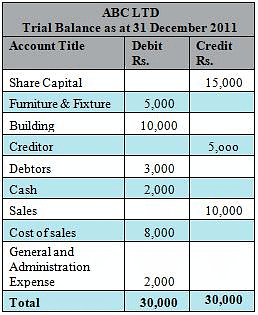
- The title provided at the top shows the name of the entity and the accounting period end for which the trial balance has been prepared.
- Account Title shows the name of the accounting ledgers from which the balances have been extracted.
- Balances relating to assets and expenses are presented in the left column (debit side), whereas those relating to liabilities, income, and equity are shown in the right column (credit side).
- The sum of all debit and credit balances is shown at the bottom of their respective columns.
Errors which are Undetectable by a Trial Balance
A trial balance can catch mathematical mistakes in the general ledger, but there are some errors it can't detect. Here are a few:
- Complete omission: The transaction wasn't recorded at all.
- Error of original entry: Both sides of the transaction have incorrect amounts.
- Error of reversal: The correct amounts are entered, but the debited account is credited and vice versa.
- Error of Principle: The transaction violates basic accounting principles, like using the wrong type of account.
- Error of Commission: The transaction amount is right, but the debited or credited account is wrong, often due to oversight.
Suspense Account and Its utility in preparing Trial Balance
- Suspense: If the trial balance does not tally due to the existence of one sided errors accountant has to carry forward his accounting process prepare financial statements. The accountant tallies his trial balance by putting the difference on the shorter side as “suspense account”.
- Utility of Suspense Account: The main use of suspense account is to facilitate the preparation of financial statements. Later on errors affecting the trial balance are located; rectification entries are passed through the suspense account.
Solved Examples
Problem 1: Creative Advertising, owned by Miss Abida Masood, provides advertising consulting services. During January 2011, the following events occurred.
Jan. 2 Owner contributed Rs. 50,000 and a new computer costing Rs. 20,500 to start her business.
Jan. 4 Office supplies were purchased on account for Rs. 4,000.
Jan. 10 Creative Advertising obtained a 12% 5-year loan of Rs. 20,000 from the bank.
Jan. 12 Creative Advertising paid the utility bills for Rs. 2,750.
Jan. 15 Paid the Rs. 3,000 in Accounts Payable from the purchase of office supplies on Jan. 4.
Jan. 24 Advertising services completed in January were billed to clients Annies’ Flowers at Rs. 18,300.
Jan. 27 Creative Advertising received Rs. 5,500 from Annies’ Flowers, a client, as payment on account.
Jan. 30 Miss Abida Masood withdrew Rs. 6,000 cash for personal use.
Requirement: You must pass a Journal Entry, post to the appropriate general ledger account, and make a trial balance.
Solution:
Journal Entry:
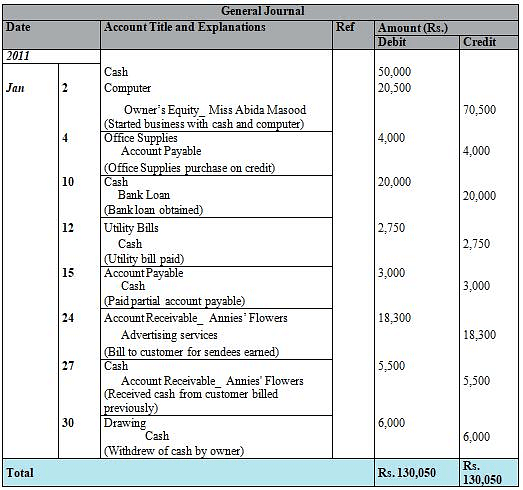
General Ledger and Trial Balance:











Problem 2: Shah Garden Center is retail garden supplier. Record the transactions needed to journalize, post to respective ledger account and prepare Trial Balance of the following for October, 2011 of the current year:
Oct. 2 Purchased inventory on credit terms of 1/10 net 30. FOB shipping point, for Rs. 3,000. Freight charges on the purchase were Rs. 150.
Oct. 9 Sold garden supplies on credit terms 3/20 net 30, FOB shipping point, for Rs. 4,000. The cost of the supplies sold was Rs. 2,500.
Oct. 10 Paid the amount owed on account for the Oct. 2 inventory purchase.
Oct. 15 Received merchandise that was returned as defective, originally sold for Rs. 500 on Oct. 9. The original cost of the supplies returned was Rs. 275.
Oct. 25 Received payment on account for the Oct. 9 sale less the appropriate sales discount.
Oct. 28 Inventory lost by fire of cost Rs. 350.
Solution:
Journal Entry
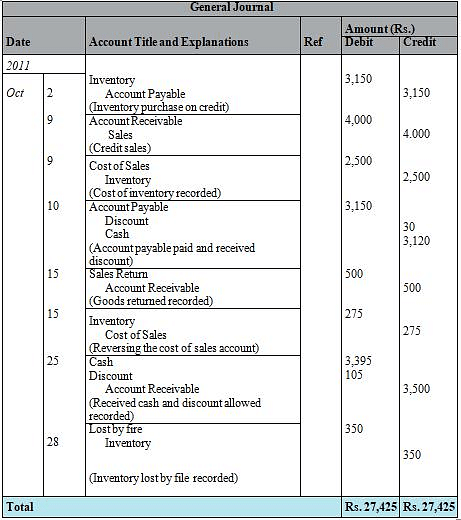
General Ledger and Trial Balance


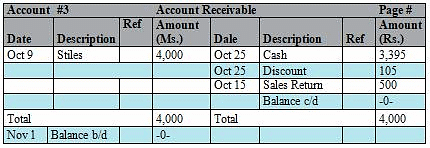






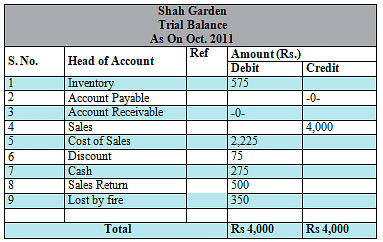
Problem 3: Record the following transaction in T accounts directly.
Solution: Directly Recording in T Accounts
(a) The business purchase product for stock and pays Rs. 3500 Cash for purchases.

(b) A business pays a telephone bills for Rs. 425
(c) A business pays Rs. 1,200 for bank loan
Problem 4: Post transactions to appropriate T-account & make Trial Balance for ABC Ltd as on June 30th, 2008.
- Owner investment in Cash Rs. 10,000
- Borrowing Rs. 1,000 from a local bank on a Note due in three months
- Purchase Equipment of Rs. 500, paid Rs. 100 Cash and promising the rest on a Note Payable
- Paid Rs. 150 for Stationery
- Lent Rs. 200 to an employee who signed a Note promising to repay within 60 days
- Service Revenue received during the period is Rs. 5,800
- Paid Insurance for three year at start of this accounting period Rs. 1,800
- Service Revenue of worth Rs. 1,200 earned but not received
- Insurances expired recorded as Insurance Expense of Rs. 600
- Personal withdrawal of owner of Rs. 700
Solution: Ledger and Trial Balance




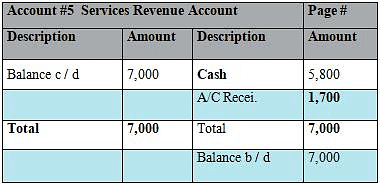

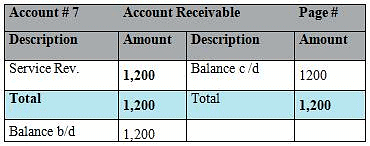



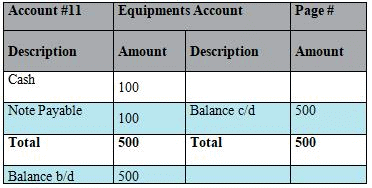

|
44 videos|75 docs|18 tests
|
FAQs on Journal, Ledger and Trial Balance - Accountancy and Financial Management - Accountancy and Financial Management - B Com
| 1. What are the rules of Debit and Credit in accounting? |  |
| 2. What is the purpose of a Ledger in accounting? |  |
| 3. What are Ledger Accounts and how are they different from a Ledger? |  |
| 4. What is the difference between a Journal and a Ledger in accounting? |  |
| 5. What is the purpose of a Trial Balance in accounting? |  |




















